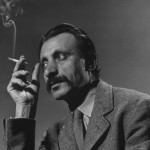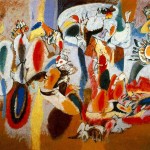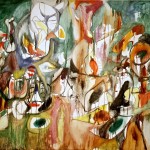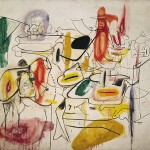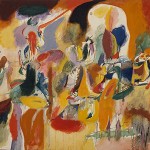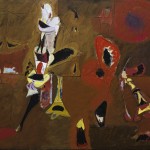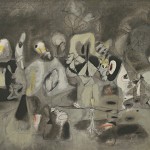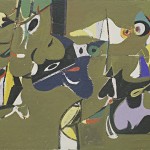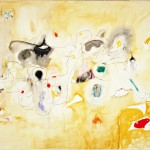Arshile Gorky

Arshile Gorky was born in the village of Khorgom, located on the shores of Lake Van. between 1902 and 1905. (there is some discrepancy as to the actual date of his birth) In 1910 his father moved to the United States to avoid the draft, leaving his family behind.
Gorky fled his home town in 1915 with his mother and his three sisters during the Armenian Genocide and escaped into Russian-controlled territory where Gorky’s mother eventually died of starvation in 1919. Arriving in the United States in 1920, Gorky was married at the age of 31. He also changed his name to “Arshile Gorky” as a way of reinventing his identity, he even told people that he was a relative of the famed Russian writer Maxim Gorky.
Click here to continue reading
Willem De Kooning once said: “I have met a lot of artists – but then I met Gorky… He had an extraordinary gift for hitting the nail on the head; remarkable. So I immediately attached myself to him and we became very good friends. It was nice to be foreigners meeting in some new place.”
In the 1940’s his influence of Cezanne and Picasso gave way to his own style, and what many consider to be his greatest work. Gorky showed his new work to influential Surrealist Andre Breton, after seeing the new paintings and in particular The Liver is the Cock’s Comb, Breton declared the painting to be “one of the most important paintings made in America” and he declared that Gorky was a Surrealist, which was Breton’s highest veneration. The painting was displayed in the Surrealists’ final show at the Galerie Maeght in Paris in 1947.
Sadly, the era that produced Gorky’s greatest work was cut short, and his final years were filled with tremendous pain and heartbreak. The 1940’s saw his studio burned down, he was diagnosed with cancer, his neck was broken and his painting arm was temporarily paralyzed due to an automobile accident, and to make matters worse his wife left him after seven years of marriage, taking their children with her. Gorky hanged himself in Sherman, Connecticut, in 1948, at the age of 44 where he is now laid to rest.
Gorky once said: The stuff of thought is the seed of the artist. Dreams form the bristles of the artist’s brush. As the eye functions as the brain’s sentry, I communicate my innermost perceptions through the art, my worldview.
- Photograph of the artist
- The Liver is the Cock’s Comb – 1944
- One Year the Milkweed – 1944
- Good Hope Road – 1945
- Untitled – 1944
- Water of the Flowery Mill – 1944
- The Leaf of the Artichoke Is an Owl – 1944
- Agony – 1947
- Diary of a Seducer – 1945
- Garden in Sochi – 1941
- The Plough and the Song – 1947

